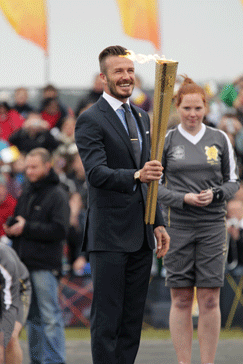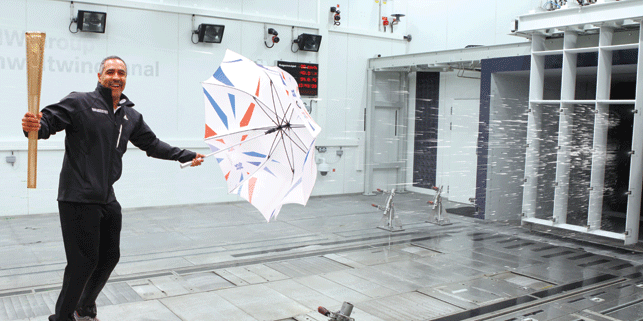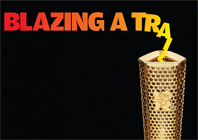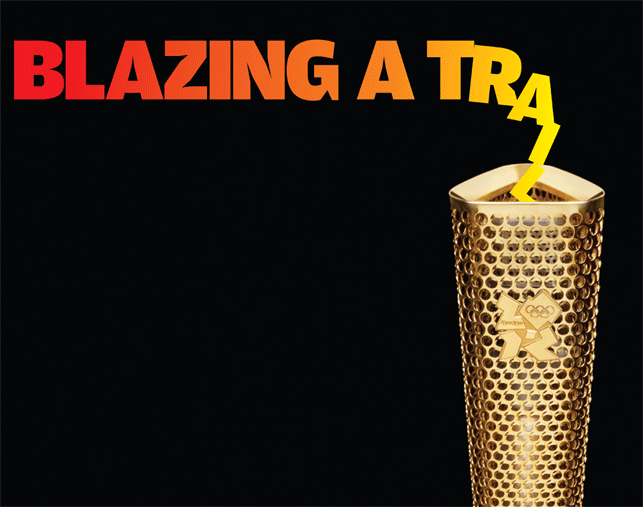
The Olympic torch is one of the most recognisable symbols of the Olympic Games
Standing 800mm tall and perforated with 8,000 small holes, the golden London 2012 Olympic Torch has become a powerful symbol in its short life.
Having arrived on British soil on 19 May from Athens, where it was lit in a ceremony on Mount Olympus, it will be passing (or has already passed) within an hour of 95 per cent of UK residents in its 70 day 8,000km relay before arriving at the Olympic stadium on 27 July.
The designers who originally came up with the ambitious design, Edward Barber and Jay Osgerby of London-based design studio BarberOsgerby, have been praised for its beauty, lightness and simplicity. In April 2012 the studio even received the ‘Design of the Year’ award at a ceremony hosted by the Design Museum in London.
However, it was the engineers who helped turn their design idea into a manufacturable product.
“It was a challenge for us as BarberOsgerby wanted it to be a very honest torch. In other words, they wanted the inner workings to be on show whereas in most other torches from previous Games you can’t see the burner or canister,” says Stuart Hawker, managing director of TECOSIM Technical Simulation, which was responsible for the design, engineering and testing of the torch through the use of computer-aided engineering (CAE), fluid dynamics and wind tunnels.

Creating the hole pattern proved to be rather challenging as TECOSIM had to make mild styling changes to it
Taking part
BarberOsgerby won the opportunity through a competitive tender run by the London Organising Committee of the Olympic and Paralympic Games (LOCOG) and the Design Council.
Simultaneously, LOCOG also invited engineers and manufacturers who were interested in being involved in the Olympic Torch project to register on its website. Some of these companies were then asked to an immersion session, along with other suppliers, to discover what the project would entail. “At that stage we hadn’t seen BarberOsgerby’s torch and had no idea of the challenge we were going to be faced with,” says Hawker.
In December 2010 the team at TECOSIM met Barber and Osgerby for the first time and the torch design was revealed to them.
“We thought it was a beautiful design but as the torch has so many holes, it was a slight concern to us because firstly, how are you going to make it and secondly, how will you protect the burner itself? As the flame has to be protected, the design needs to be as robust as possible so the flame doesn’t go out,” comments Hawker.
Let the engineering begin
BarberOsgerby and TECOSIM were to work very closely during the development process, which started off with the former handing over the design files. “They supplied us with an output file from their rendering software. This gave us just the surfaces so we had to really start from scratch building a 3D model,” says Hawker.

UK footballer David Beckham was one of the first people to hold the torch at the start of its 70 day relay on 19 May
TECOSIM wanted to keep as true to BarberOsgerby’s design as possible especially as it thought the narrative behind the 8,000 holes was very poignant with each hole representing one of the 8,000 torchbearers who will be carrying the torch on its relay across the UK.
“Our philosophy from the start was that we wanted to stay as faithful as we could to the BarberOsgerby design,” says Hawker.
However, having built a 3D model, the TECOSIM engineers realised that mild styling changes needed to be made to the original hole pattern. Specifically, it had to optimise some of the holes around the burner fixing point. “We did quite a lot of CAE work to understand the stresses of the material around that point and in the end we had to optimise the hole pattern so that we could get the right strength of the material so that the torch wouldn’t break or fail if it were dropped.
“We went for a single fixing point that attached the burner, which also acts as the on/off switch for the burner system,” says Hawker.
The new design was then subjected to many virtual tests and analysis in order to meet LOCOG’s operating requirements. These included withstanding temperatures of -5C to +40C, wind speeds of 35mph, gusting up to 50mph and an altitude of 4,000 feet above sea level. It would also have to survive a three metre drop and perform well in high humidity as well as rain and snow.
“We did a lot of computer work for the aerodynamics, specifically looking at the effects of the wind. We also did a lot of drop test simulations in order to analyse its strength and durability.”
However, TECOSIM was involved in more than just the engineering side. “We did an awful lot of research into different aspects of the torch design including aspects of the burner and canister as well as material selection. We then had to successfully bring all these different aspects together.”

TECOSIM relied heavily on CAE in the development of the torch
Lighting the way
One of its biggest challenges was the optimisation of the burner system. Working with Birmingham-based propane gas specialists and manufacturers Bullfinch on a bespoke system, the flame had to be big enough to be seen by the audience in the Olympic stadium and strong enough to not be blown out on its 70 day journey there.
“Bullfinch took a design it already had and made it work with the torch. But with the torch being so open with so many holes that didn’t offer any protection, we needed a very strong burner,” comments Hawker.
The burner system works like a miniature hot air balloon using a vapour off-take system, which uses a cylinder full of liquid gas. The top of the liquid is heated by the flame, turning the boiling liquid into a gas. The canister is filled with two-thirds propane and one-third butane.
While Bullfinch worked on the system itself TECOSIM had to ensure that the burner and canister weren’t ejected from the torch if dropped from a height of three metres. “We did a fair bit of upfront work with Bullfinch to develop the burner,” says Hawker. “We knew that we had something very strong, it was just a matter of making sure it stayed integral inside the torch.”
All that glitters
When it came to selecting the best material for the job, TECOSIM chose a special aluminium alloy, which is predominantly used in the aerospace and automotive industries. The advantages are that the alloy is lightweight, strong and has excellent heat resistance. “There wasn’t actually a weight target set by LOCOG but because 12 year olds would be carrying the torch, we knew we had to make it as light as possible.
“Aluminium was also a good choice because it is very good at dissipating the heat. This means you can hold the torch very high up when it is operating and you won’t burn yourself.”
Part of the challenge of selecting a material was also finding a suitable finish. “LOCOG wanted to have something that was highly reflective and looked like gold. This wasn’t easy to find but we did manage to source a coating called Physical Vapour Disposition, which provides excellent colour consistency, surface finish, reflectivity, high hardness and wear resistance as well as being a thin coating,” says Hawker.
Accurate simulations
As TECOSIM relied heavily on computer simulations, it only had four physical production prototypes produced in total.
Two were created for the initial drop tests and then a further two created for the wind tunnel sessions. “We took two pre production samples to a test place and drop tested them just before Christmas 2011 to effectively just prove it out.
“We had very good correlation between the test results and the CAE work, which meant that we didn’t actually have to go back and change anything afterwards.”
To further test the development work TECOSIM had done itself, the physical production prototypes were then taken to BMW Group’s Energy and Environmental Test Centre in Munich, Germany. Here in the wind tunnel the torch was really put through its paces and tested in all sorts of extreme weathers. This may seem a bit drastic but the torch had to survive anything a typical British summer could throw at it including the possibility of snow as it was to be carried up to the summit of Mount Snowdon, during the Olympic relay.
Back in Basildon, TECOSIM also carried out some of its own testing. “We did a lot of in-field testing ourselves in secret away from any prying eyes all through last summer and into the Autumn,” says Hawker.
“The rain you get in a wind tunnel is quite artificial and it’s set up more for vehicle testing so it’s much more like spray you get off lorries and cars. We wanted to test it in the sort of rain you get in the UK, which can be accompanied by high winds, so when the weather was particularly bad we’d drive to locations such as a Kent beach and test it ourselves.”
In September 2011, TECOSIM went back to BMW’s wind tunnel but this time with representatives from LOCOG. “We proved to them what the torch can withstand and that it is very robust,” says Hawker.

With the assistance of British Olympic legend Daley Thompson, the Olympic torch stood up to some extreme weather conditions in BMW’s wind tunnel
Forming the sheets
Following sign-off, the next stage was manufacturing. BarberOsgerby initially envisaged an additive manufacturing process being used to produce the torches. But with 8,000 torches to be made, this process was deemed to be too risky as it’s still relatively new. So, instead the processes of Coventry manufacturers Premier Sheet Metal were used to shape and form the aluminium sheets.
The torch is made of two ‘skins’ of aluminium alloy, one on the outside and one on the inside, which have the holes laser cut into them. They are then formed and laser welded together and held in place by a cast top piece and base. “The idea is that if someone picked the torch up they wouldn’t necessarily understand how it’s made.
“It’s quite mysterious in the way it’s put together.”
Proud moment
For TECOSIM, being involved in the development of the Olympic torch has been a project a bit out of the ordinary. “A lot of the work we do tends to be in the automotive sector but nobody would ever really know what we do because we aren’t allowed to say so. The beauty of this project is LOCOG were very kind and let us have it open so that people would know that we have engineered it.”
Hawker also hopes that by being involved in the creation of such a beautiful and high profile piece of design can prove that engineering can be an art form.
“Normally people see the design and they think of the designers but we as the engineers are obviously trying to bring that design to life. We are taking that idea and making it into something that can be made and can be operated in its environment. This is not always easy because there is no set solution – you have to do it on an evolving basis over the project time.”
When the torch eventually enters the Olympic stadium on 27th July and is used to light the Olympic cauldron, there will no doubt be some very proud people watching. “We are extremely proud of the design and we hope that it will show off how well design and engineering can work together to deliver something so iconic.”
tecosim.com
barberosgerby.com
premiersheetmetal.com
An Olympic torch engineered to compete against the worst of the British weather
Default






